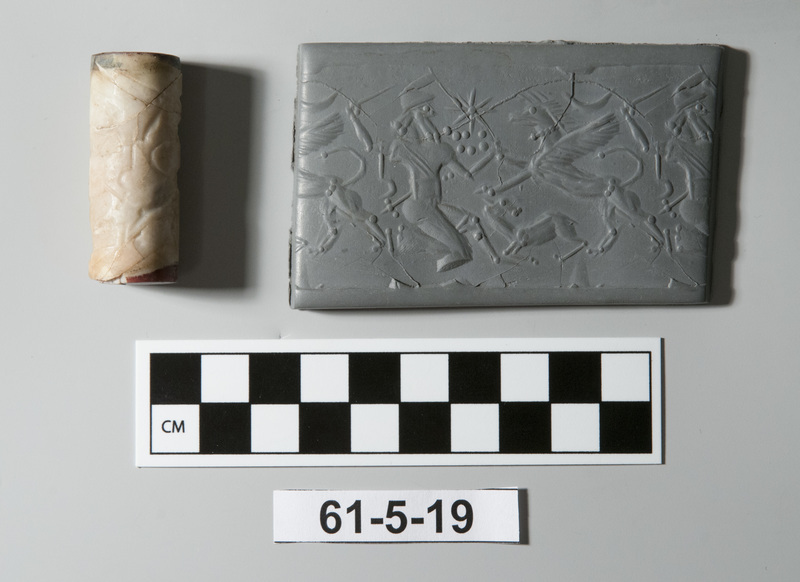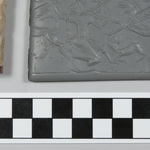Cylinder Seal
61-5-19
From: Iran | Hasanlu
Curatorial Section: Near Eastern
| Object Number | 61-5-19 |
| Current Location | Collections Storage |
| Provenience | Iran | Hasanlu |
| Archaeology Area | LXXVIII(3)[2]/13 |
| Locus | Doorway West |
| Section | Near Eastern |
| Materials | Marble (uncertain) (Stone) |
| Description | From Marcus Publication: "White chert (?). Bronze pin in perforation; purple stains at both ends from copper/bronze caps, now missing. Surface cracked,"
Probably purple marble burnt white where exposed, sections once covered by bronze caps may show original color; seal cracked probably owing to exposure to heat; part of bronze pin still in perforation. At upper end of cylinder, band of bitumen originally used to cement bronze cap, below bitumen band, light green stains produced by metal cap; lower end, very slight traces of bitumen and no green stains. Such differences in traces of bronze setting suggest different caps at top and lower bottom. Taken together with stump of pin at lower end, evidence suggests that cylinder served as pin head rather than pendant which was usual in period. Scene: Hero and griffin contending for kneeling hoofed animal. Hero kneels on one knee and grasps with one hand the forepaw of a griffin, menacing the monster with a dagger held in the other hand. From his upper arm hangs a scimitar, pointing backward. The hero has a brimmed cap or miter, hair curled up at the ends, indicated by two lines each ending in a drilling of which one rests on the hero's shoulder. He wears a short-sleeved shirt and a mantle tied with a broad belt. The mantle appears as an oblique band running from sleeve to belt and carried on below the belt by two short lines which merge into the covering of the bent leg. Above the ankle, the mantle ends in a border of three drillings. Other leg uncovered and shows hem of the shirt above the knee. The griffin has a necklace indicated by drillings with a larger drilling projecting in front, probably meant to indicate a pomegranate. The animal between hero and griffin may be a calf though its tail is too short for a correct rendering of the animal. Eight-pointed star, seven globes (Pleiades) and crescent in the sky. Style: The cylinder belongs to the group which I have called in Corpus of Ancient Near Eastern Seals in North American Collections. In the Cut Style. I believe the main forms in the designs of this style to have been produced by holding the cylinder at different angles against a rotating cutting wheel. Details were subsequently added by small drillings. Careful work such as found on the present piece, and the large size of the seal stone suggest a date not later than the ninth century B.C. Another indication for an early date of the piece is the motif showing two figures contending for a kneeling victim which is frequently found on Middle Assyrian and Middle Babylonian cylinders. Lastly the outline of the hero's hair which forms a wedge resting on the shoulder corresponds with one angle to the fashion in the time of Ashur-nasir-pal and Shalmaneser III in the 9th century rather than to the later fashion in which the hair forms a more or less square mass with horizontal base. |
| Credit Line | The Hasanlu Project; Robert H. Dyson Jr., 1961 |
| Other Number | HAS60-13 - Field No SF |
Report problems and issues to digitalmedia@pennmuseum.org.



